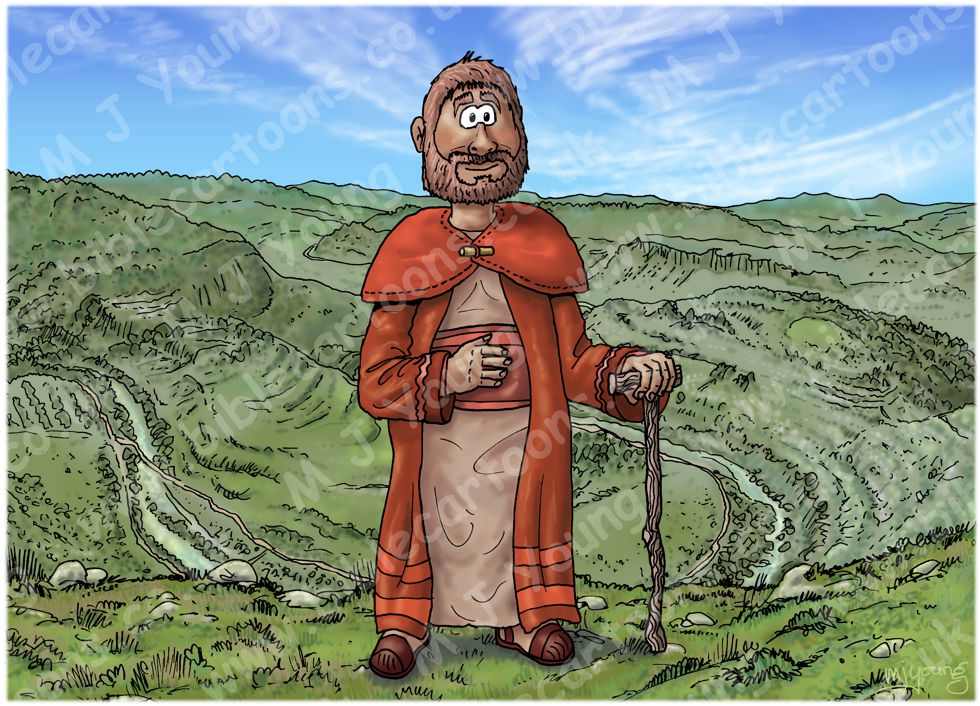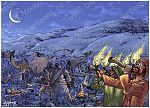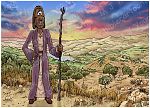Bible Cartoon: Judges 10 - Tola, Israel’s sixth judge
Click on Add to cart button below shopping cart.
Purchased Bible Cartoons do not have watermarks. Links to Cartoons provided on email once purchase is completed.Bible Book: Judges
Bible Book Code: 0701000101
Scene no: 1 of 1
Bible Reference & Cartoon Description
Judges 10:1-2 (ANIV)
Tola
1 After the time of Abimelech a man of Issachar, Tola son of Puah, the son of Dodo, rose to save Israel. He lived in Shamir, in the hill country of Ephraim. 2 He led [1] Israel for twenty-three years; then he died, and was buried in Shamir.
[1]
Traditionally, judged; also in Judges 10:3.
DRAWING NOTES:
TIME OF DAY:
Unspecified in the Bible narrative. I have set the scene in the early afternoon.
LIGHTING NOTES:
The sun (unseen & high in the sky on the left) illuminates this scene, casting shadows below & to the right of the figure & objects.
CHARACTERS PRESENT:
The judge named Tola.
RESEARCH/ADDITIONAL NOTES:
This scene shows Tola son of Puah, standing on a hillside in the hill country of Ephraim. As the notes below explain the name Tola refers to the colour scarlet, hence Tola’s clothing being various shades of red in colour.
Tola (and Jair who followed him) were among the so-called “minor judges” but in fact they were no less significant in delivering Israel during the period of history before the monarchy began (with king Saul & later king David). The judgeship of Tola in particular was a temporary counteraction to the decay under the rule of Abimelech (see Judges chp 9).
Interestingly Tola was a Judge in the hill country of Ephraim, but was a man born into the tribe of Issachar, which had its land further north, & south west of the Sea of Galilee. His judgeship may have affected the adjacent tribe of Manasseh where Abimelech’s petty kingdom had been established (see Judges chp 9).
Tola judged Israel for 23 years before his death. No-one knows for sure where the site of the village/town of Shamir is, which was Tola’s place of residence and burial.
Tola’s acts of deliverance seem to have been restricted to internal matters within Israel, rather than as a result of foreign attack or invasion. Perhaps his deliverance came as a result of the sad state of affairs (including that of Abimelech’s rule) which followed the positive influence of Gideon’s deliverance.
Here’s the landscape without the figure.

Background of Judges 10 – Tola, Israel’s sixth judge
Click on the colour bar below to view/buy this Background:
Background of Judges 10 – Tola, Israel’s sixth judge

Map - The 12 Judges home towns or locations
Click yellow bar below to see Maps: The 12 Judges home towns and locations, with download & purchase options:
Map – The 12 Judges home towns or locations
A note on the origin of the name Tola.
The name Tola translates into “scarlet” or scarlet in colour, especially in reference to clothing. It also refers to an insect (considered a worm) from which the ancients extracted the precious dye called “crimson.” In fact, the word “crimson” itself comes from the word Kermes, and can be traced back to the Arabic AL-QIRMIZ, “crimson,” which likely originated from the ancient Sanskrit word K?MI-JA meaning “worm-made.”
An interesting website gives these details regarding the word Tola, & its insect connection:
“The Israeli Common Oak, also called the Palestine Oak, or officially Quercus calliprinos, is a variety of the Kermes Oak. It is a low-growing shrub-like tree. On these particular trees are often found an insect that was called in earlier times coccus ilicis in the Latin, and by the modern name of Kermes vermilio. The designation of vermilio is telling us that this little guy is a worm.
…An interesting aspect of this creature is what it goes through in order to birth its young. While the insects are born with legs, the females eventually lose the use of their legs, which is apparently why they were given the designation of a “worm.” Shortly thereafter, the following amazing events happen:
When the female of the scarlet worm species was ready to give birth to her young, she would attach her body to the trunk of a tree, fixing herself so firmly and permanently that she would never leave again. The eggs deposited beneath her body were thus protected until the larvae were hatched and able to enter their own life cycle. As the mother died, the crimson fluid stained her body and the surrounding wood. From the dead bodies of such female scarlet worms, the commercial scarlet dyes of antiquity were extracted.
~ Henry Morris. Biblical Basis for Modern Science, Baker Book House, 1985, p. 73”
[Source: https://www.randomgroovybiblefacts.com/messiah_the_worm.html]





